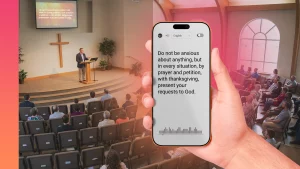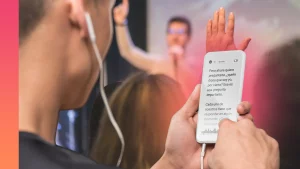
How AI Is Changing the Way Churches Communicate
How AI Is Changing the Way Churches Communicate Church communication has always been about connection: connecting people to faith, to community, and to one another.
In today’s digital age, churches are no longer limited to church pews and speaking just one language. Nowadays, you can access sermons online, which means more than one language should be available. AI sermon translation tools make this a possibility. At the click of a button, ministries can share the Gospel faster and further than ever before. But here’s the big question: Should you trust AI to handle your sermon translation, or is it worth bringing in a real human translator? The answer may surprise you. Below, we’ll explore which option is more ideal.
When you think of AI translation for sermons, picture a ministry assistant who is quick, available to help day or night, and is relatively affordable. With their help, you’ll have a translated sermon at your fingertips within seconds. Your sermon will be translated to spread the message to those who otherwise wouldn’t understand it, so everyone feels included. Regardless of the language the message is in, everyone deserves to hear it and feel the connection it brings. Some of the benefits of AI sermon translation include:
Having a human translator can be ideal depending on the situation. When you need accurate sermon translation that captures not just the words but the heart of your message, humans have the edge. They:
As a founder of Multitude, and with over 20 years of experience providing professional translation and interpreting services, Enrique recommends asking two simple but powerful questions before deciding if AI is enough:
For human translations, Multitude is a highly recommended option. Multitude is an organization that helps various ministries train their volunteers or provide professional translation in any language. They work with the Billy Graham Association, LifeWay, Saddleback Church, Adrian Rogers, Francis Chan, Andy Stanley, and many more.
For AI translations, Sermon Live is the real-time tool that will make translating your sermons simple. You’ll be able to translate your sermons in 30+ languages with only a 3-second delay.
While there are benefits for both using AI and humans for sermon translations, it’s up to preference and circumstances for which one to use. When afforded, human translation is a great option, and if it’s not within the budget, AI is a reliable solution. Regardless of the one you choose, these are both solid tools and resources you can use to ensure you have a positive experience.

How AI Is Changing the Way Churches Communicate Church communication has always been about connection: connecting people to faith, to community, and to one another.

How Translating Sermons Builds Trust and Inclusion in the Community Creating a church where everyone feels welcome is important. One of the most powerful ways

How to Build a Multilingual Ministry Without Overwhelming Your Team Creating a multilingual ministry is not only one of the most rewarding ways to grow